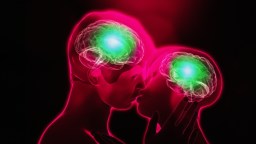The Brain in Love

There are precious few love songs that mention the brain, which is unfortunate because the brain, according to research by biological anthropologist Helen Fisher, is at the heart of love.
According to Fisher there are three components to love. The first is lust, or the craving for sexual gratification. The second is romantic love, which she says exhibits as “that elation, the giddiness, the euphoria, the obsession, the craving of passionate, obsessive love.” The third is attachment and companionship, which Fisher says is “that sense of calm and security you can feel for a long-term partner.”
Each of these components can work at the same time, independent of the others, and each can lead in any combination to love, says Fisher. Love, in this sense, is a threshold reached by a combination of the levels of the attachment, attention and lust. Yet, for Fisher, this is a love composed in the strict chemistry and architecture of the brain.
When one of these love-components is stoked, such as through an unexpected moment of companionship or openness or intimacy, a cocktail of neurotransmitters is released. Dopamine, a natural stimulant, and serotonin, which is linked to feelings of well-being. As well, the neuropeptide oxytocin has been linked with a range of behavior, from bonding in a relationship to gender differences in parenting.
What separates full-out love from more mild occurrences of attraction or companionship is the correct combination of components and their corresponding neurochemicals. This means love works on the principle of a brain-based tipping point, where only enough of the right chemicals at the right time will lead to amore. It also means that that everything counts in the brain. Each such encounter registers on the specific neural network that leads to love. This is why Fisher says there is no such thing as casual, or rather no-chemicals-attached sex, since any sexual stimulus might lead to the right combination of neurochemicals that result in love.
These chemicals are doled out by a cluster of neurons in what would be the basement of the brain, a spot called the ventral tegmental area. Fisher says this love hub at the base of the brain, when triggered, activates specific cells call A10 cells, which in turn begin the process of producing dopamine and the other neurotransmitters.
Where love loses its luster is in that the network of chemicals and neuron clusters triggered by the VTA stretch out into brain regions particularly associated with reward, rather than empathy or higher-function reasoning. Love, in this sense, is an evolutionary urge stemming from the primitive part of the brain that seeks bursts of natural neurochemicals. Love seems to be foremost about the lover, rather than the beloved. A 2005 study by Fisher, for example, used functional magnetic resonance imaging (fMRI) to study the brains of people intensely in love. This study concluded, “romantic love is primarily a motivation system, rather than an emotion.”
Moreover, since love provides chemical feedback, creating the chemical response may become the drive or motivation. A study published this September in the American Journal of Drug and Alcohol Abuse notes the spate of recent interest in a possible connection between passionate love and addiction. In looking specifically at “love addiction,” this study concluded that while there isn’t the data to classify such love as a type of addiction or disorder, it nonetheless has a “phenomenology that has some similarities to substance dependence.”
But the neurobiology of love isn’t summed up by bleak-seeming brain urges. As Fisher says, what’s activated during love is actually a “brain system for wanting, for craving, for seeking, for addiction, for motivation and in this case, the motivation to win life’s greatest prize, which is a good mating partner.”
Moreover, as Fisher says, since love is found in the earliest forming parts of the brain tracked back along the evolution of mammals, love might reach beyond only humans.
“I think that other animals too fall in love also,” says Fisher. Researcher such as Larry Young at Emory have studied the dopamine activity in voles during mating season. “You see the same dopamine activity,” Fisher concludes from the research of love-loaded neurochemicals in non-human. “Different parts of the brain,” she adds, “but you see an elevation of dopamine activity in other animals the way you do in people.”
The Takeaway
The brain is primed to respond to three sources of love: romance, companionship, and lust. These sources trigger a cocktail of neurochemicals in the brain associated with motivation, linking love to the most primordial urges of the species.
Poets have long housed love in the heart or soul, but now host of scientists are linking amorous feelings to the natural neurochemicals dopamine and oxytocin. New research is allowing scientists to chart what happens during love in that most unlikely of organs, the brain.
Learn More
Fisher, H., et at., “Romantic Love: And fMRI Study of a Neural Mechanism for Mate Choice.”
Ditzen, B., et al., “Intranasal Oxytocin Increases Positive Communication and Reduces Cortisol Levels During Couple Conflict.”
Gordon, I., et al., “Oxytocin and the Development of Parenting in Humans.”





